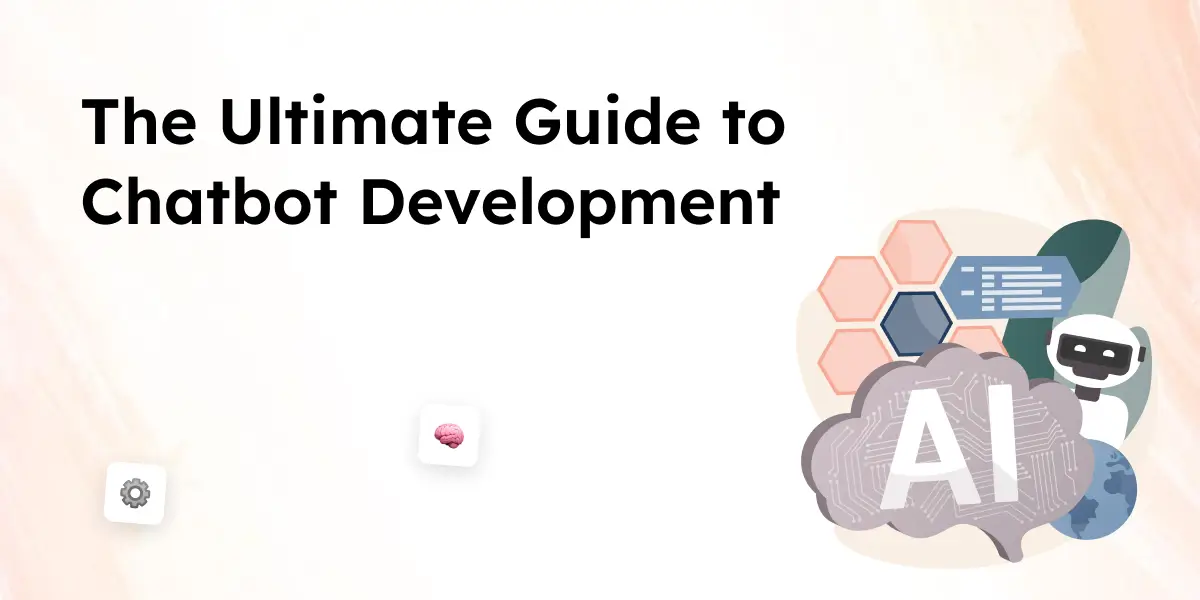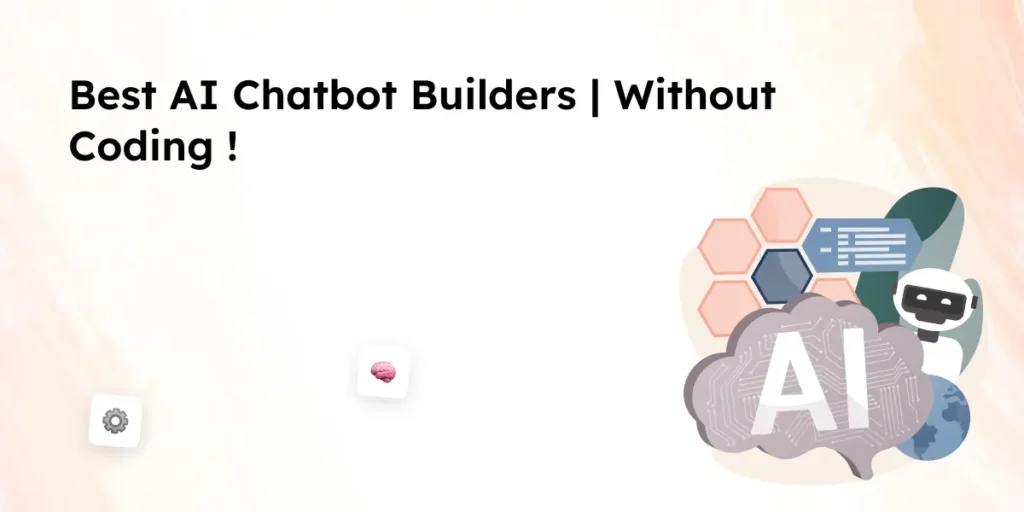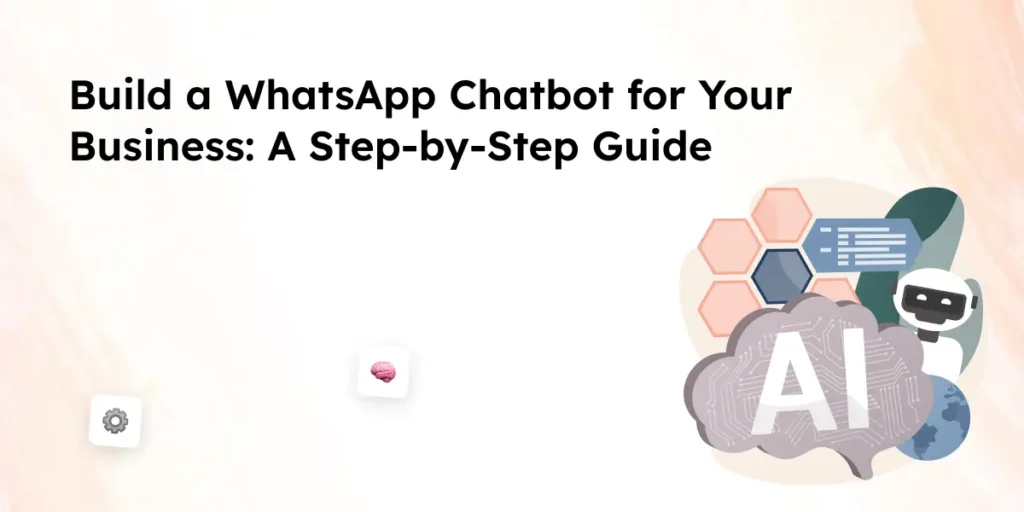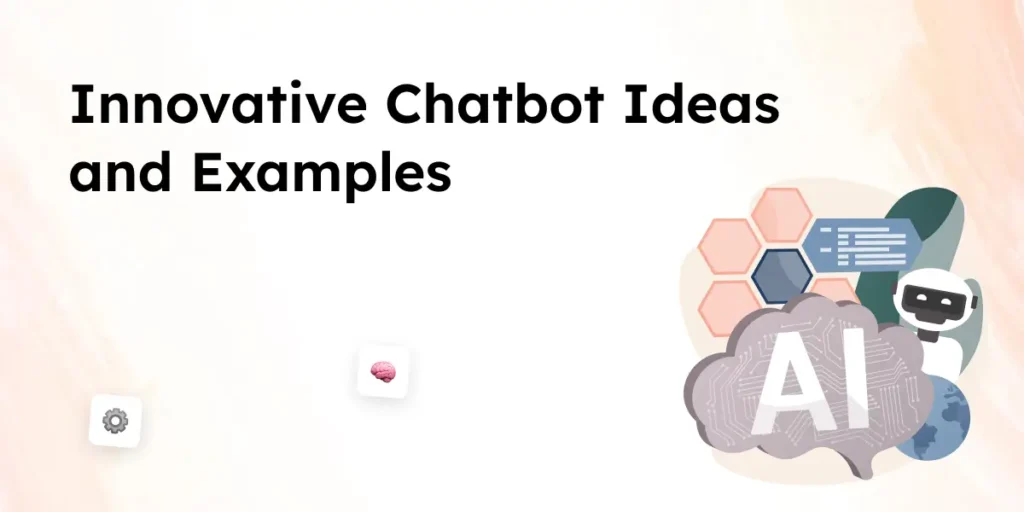Chatbots help businesses automate conversations, improve customer support, and handle large volumes of queries efficiently. The chatbot development process includes designing, training, and deploying bots that use artificial intelligence and natural language processing to enhance user experience. Developing a chatbot requires strategic planning. For businesses looking to build an enterprise-grade chatbot, our guide on Enterprise Chatbots provides insights into advanced capabilities.
This guide covers types of chatbots, selecting a chatbot development platform, best practices, development costs, and how to create a chatbot from scratch or with a bot platform.
Understanding Chatbots & Their Use Cases
A chatbot is a software application designed to simulate human-like conversations. Businesses use chatbots to automate customer support, improve response times, and reduce operational costs. These bots can be integrated into messaging platforms, websites, or mobile apps to assist users with common queries.
Types of Chatbots
Chatbots can be categorized based on their functionality and level of intelligence:
- Rule-based chatbots: These bots operate using predefined rules and workflows. They are best for answering simple, structured queries but struggle with complex interactions.
- AI chatbots: These bots use artificial intelligence and machine learning to improve responses over time. They understand natural language and can engage in more dynamic conversations.
- Hybrid chatbots: These combine rule-based logic with AI to handle structured and unstructured queries effectively.
- Virtual assistants: More advanced AI-powered chatbots that provide personalized recommendations and perform complex tasks, such as scheduling appointments or processing transactions.
Read More : Exploring 6 Different Types of Chatbots: A Guide to AI Chatbots for Your Business
Common Use Cases for Chatbots
Chatbots are used across different industries to streamline interactions and enhance customer experience. Some common use cases include:
- Customer support: Automating FAQs, troubleshooting issues, and reducing wait times.
- E-commerce: Assisting users with product recommendations, order tracking, and payments.
- Banking & finance: Handling account inquiries, fraud detection, and transaction processing.
- Healthcare: Offering symptom checking, appointment scheduling, and medical advice.
- Education: Providing personalized learning paths and answering student queries.
Selecting the appropriate chatbot platform depends on business needs and the type of chatbot required. Some companies prefer to build chatbots from scratch, while others use chatbot frameworks or chatbot development services to speed up the process.
How to Develop a Chatbot: Step-by-Step Guide
Developing a chatbot involves several stages, from defining business goals to testing and deployment. Businesses can either build a chatbot from scratch or use a chatbot development platform to streamline the process.
Step 1: Define the Chatbot’s Purpose
Before starting chatbot development, it’s essential to determine what the bot needs to accomplish. A chatbot can help businesses with customer support, lead generation, appointment scheduling, or automating repetitive tasks. Identifying business needs ensures that the chatbot serves a clear purpose.
Step 2: Select the Right Chatbot Development Platform
Choosing a chatbot platform depends on the complexity of the bot, required integrations, and available resources. Some platforms like Dialogflow, IBM Watson, and Microsoft Bot Framework offer AI capabilities, while simpler options allow businesses to create an AI chatbot without coding.
Step 3: Design the Conversation Flow
Creating a structured conversation flow is crucial for a successful chatbot. Businesses should consider:
- The types of queries the chatbot will handle.
- How it will respond to different user inputs.
- When it should escalate conversations to a human agent.
Using chatbot templates can speed up the chatbot creation process by providing pre-built conversation structures.
Step 4: Choose the Right Technology
A chatbot can be powered by artificial intelligence, natural language processing, or a predefined rule-based system. AI chatbots use machine learning to improve responses, while simpler bots follow structured decision trees. Businesses should choose technology based on their chatbot app development needs.
Step 5: Train Your Bot and Implement NLP
Training a chatbot requires feeding it with relevant data, such as past customer interactions or FAQ documents. Natural language processing helps the chatbot understand different ways users phrase queries, improving conversational accuracy. Businesses should train their chatbot regularly to enhance its performance.
Step 6: Integrate the Chatbot with Business Systems
For a chatbot to provide value, it must connect with messaging platforms, CRM software, and support systems. Integration allows chatbots to pull relevant customer data and offer personalized responses. Businesses can integrate their chatbot with platforms like Facebook Messenger, WhatsApp, or live chat systems.
Step 7: Test Your Chatbot Before Deployment
Testing is a critical step in chatbot development. Businesses should test the chatbot for:
- Response accuracy.
- Handling unexpected queries.
- Seamless conversation flow.
Testing tools help identify issues before deployment, ensuring the chatbot delivers a smooth user experience.
Step 8: Deploy and Monitor Performance
Once the chatbot is live, businesses should continuously monitor its interactions. Tracking key performance indicators like response accuracy, user engagement, and escalation rates helps optimize chatbot performance over time. AI models can be updated to improve the chatbot’s conversational abilities.
Businesses can either develop a chatbot in-house or work with a chatbot development agency for a more advanced implementation. The right chatbot strategy depends on budget, technical expertise, and business requirements.
Building a Successful Chatbot: Best Practices
Developing a chatbot is more than just writing scripts and deploying a bot. A successful chatbot must engage users, provide accurate responses, and integrate seamlessly with business workflows. Following best practices for chatbot development ensures that the chatbot delivers a smooth user experience and meets business goals.
Define Clear Objectives
Before starting chatbot development, businesses must outline the chatbot’s purpose. Whether it’s handling customer support, generating leads, or automating processes, a clear objective ensures that the chatbot serves a meaningful role.
Use AI and NLP for Better Interactions
AI-powered chatbots with natural language processing can interpret user queries more accurately and respond in a conversational manner. Machine learning helps the chatbot improve its responses over time, making interactions more effective.
Design an Intuitive Conversation Flow
A well-structured chatbot should guide the users through a logical conversation. The chatbot should:
- Recognize common user queries.
- Offer predefined options where necessary.
- Know when to transfer the conversation to a human agent.
Ensure a Human Agent is Available for Escalations
Even the best AI chatbots may struggle with complex queries. Providing a seamless transition from the chatbot to a live chat agent improves the customer experience and ensures users receive the support they need.
Personalize Interactions
A chatbot can help create a personalized experience by addressing users by name, remembering past interactions, and offering relevant recommendations. AI chatbots can use customer data to improve personalization and increase engagement.
Optimize for Multiple Messaging Platforms
Chatbots should be available on platforms where customers are most active. Businesses should ensure their bot integrates with Facebook Messenger, WhatsApp, live chat tools, and other messaging platforms to maximize reach.
Keep Responses Short and Clear
A chatbot should avoid long messages that overwhelm users. Keeping responses concise and to the point ensures better engagement. If a query requires a detailed answer, the chatbot can provide links or suggest speaking to a human agent.
Regularly Train Your Bot and Update Content
To maintain an effective chatbot, businesses should continuously update the chatbot’s knowledge base. Regular training helps improve chatbot responses, and updating chatbot templates ensures the bot remains relevant.
Test Your Chatbot Before Full Deployment
Before going live, businesses should test the chatbot to identify weaknesses. Testing should focus on:
- How the chatbot handles different types of queries.
- Ensuring smooth handoffs to human agents.
- Checking for unexpected responses or errors.
Monitor Performance and Optimize Over Time
After deployment, businesses should track chatbot interactions and analyze key metrics. Insights from chatbot analytics help refine responses, improve the chatbot experience, and enhance overall performance.
AI Chatbot Development & Training
Building a chatbot is just the beginning. To ensure a chatbot is effective, businesses need to train their bot and continuously improve its conversational abilities. AI chatbot development relies on machine learning and natural language processing to enhance chatbot responses and make interactions more human-like.
Training a Chatbot for Better Conversations
- Collect Relevant Training Data
A chatbot learns from past interactions. Businesses should collect real customer queries, FAQs, and support tickets to train their chatbot effectively. Using high-quality data ensures the bot understands different ways users phrase questions. - Use NLP to Improve Understanding
Natural language processing helps chatbots recognize variations in user input. Instead of relying on exact keyword matches, an AI chatbot can understand intent and context. This improves chatbot accuracy and enhances the user experience. - Implement Machine Learning for Smarter Responses
Machine learning allows chatbots to improve over time by learning from past conversations. AI chatbots can adapt to user behavior, providing more accurate and relevant responses based on historical interactions. - Define Conversation Paths and Escalation Points
A chatbot should be able to guide users through different conversation paths while knowing when to escalate to a human agent. Businesses can create chatbot flows that ensure a seamless transition between automated and human support. - Train Your Chatbot to Handle Complex Queries
Simple chatbots can handle predefined questions, but AI chatbots must be trained for open-ended queries. Businesses can improve chatbot performance by continuously adding new data, refining responses, and testing different scenarios. - Use Chatbot Templates to Speed Up Training
Some chatbot development platforms provide chatbot templates that simplify chatbot creation. Pre-built templates offer structured workflows that businesses can customize based on their needs. - Test the Chatbot Before Full Deployment
Before launching, businesses should test their chatbot to identify weaknesses. The chatbot should be tested for:- Handling variations of the same query.
- Maintaining a natural and conversational tone.
- Escalating complex issues correctly.
- Monitor Chatbot Performance and Make Improvements
AI chatbot development doesn’t stop after deployment. Businesses should track chatbot interactions, analyze customer feedback, and update the chatbot’s training data regularly. This ensures the chatbot continues to improve and meet evolving business needs.
Proper training ensures that a chatbot can help businesses provide seamless customer support and automate processes effectively. Businesses that invest time in training their chatbot will see better user engagement and overall chatbot performance.
How Much Does Chatbot Development Cost?
The cost of chatbot development varies based on factors such as complexity, features, and the chosen chatbot development platform. Businesses can opt for a free chatbot with basic functionality or invest in a more advanced AI chatbot capable of handling complex queries.
Factors Affecting Chatbot Development Cost
- Type of Chatbot
- A simple chatbot with predefined responses is more affordable than an AI chatbot that requires natural language processing and machine learning.
- AI chatbots with deep learning capabilities require additional resources for development and maintenance.
- Development Method
- Using a chatbot development platform or chatbot templates can reduce costs.
- Custom chatbot app development requires coding expertise, increasing development costs.
- Businesses can hire a chatbot development agency or chatbot developers for a fully customized bot.
- Integration Requirements
- Connecting a chatbot with CRM software, e-commerce platforms, or live chat support systems may increase costs.
- Businesses that need integrations with messaging platforms like Facebook Messenger or WhatsApp should consider API costs.
- Training and Maintenance
- AI chatbots require ongoing training and updates to improve their performance.
- Businesses must allocate a budget for continuous chatbot improvements and monitoring.
Estimated Cost Breakdown
- Basic chatbot (rule-based): $500 – $2,000 (or free chatbot options)
- AI-powered chatbot: $5,000 – $30,000+ depending on complexity
- Custom chatbot with integrations: $10,000 – $100,000+ depending on business needs
- Ongoing maintenance & training: $500 – $5,000 per month
Reducing Chatbot Development Costs
- Businesses can reduce costs by using chatbot frameworks that provide prebuilt chatbot solutions.
- Selecting the right chatbot platform with built-in AI capabilities eliminates the need for custom coding.
- Using chatbot templates can speed up chatbot creation while reducing initial development costs.
- Opting for a chatbot development service with scalable pricing ensures cost efficiency for small and medium-sized businesses.
Chatbot development costs depend on business goals and the required features. Businesses should evaluate whether to build a chatbot from scratch, use a bot builder, or partner with a chatbot development agency to get the most value for their investment.
Security & Compliance Considerations in Chatbot Development
Security is a critical aspect of chatbot development, especially when handling sensitive customer data. Businesses must ensure that their chatbot complies with industry regulations and protects user privacy.
Key Security Concerns in Chatbot Development
- Data Privacy
- A chatbot collects user information, including personal details and transaction history. Businesses must implement data encryption and secure storage practices.
- Users should be informed about data collection policies to maintain transparency.
- Compliance with Industry Regulations
- Businesses handling customer data must comply with GDPR, HIPAA, and other regional data protection laws.
- Ensuring chatbot compliance with security standards helps avoid legal issues.
- Authentication & User Verification
- A chatbot handling sensitive actions, such as processing payments, should require authentication.
- Two-factor authentication and access control mechanisms can enhance security.
- Preventing Unauthorized Access
- Secure API integrations prevent hackers from exploiting chatbot vulnerabilities.
- Businesses should regularly update their chatbot platform and software to patch security risks.
- Avoiding Data Breaches
- AI chatbots should not store sensitive user information unless necessary.
- Implementing data masking and anonymization techniques can reduce the risk of breaches.
Best Practices for Chatbot Security
- Use AI technology to detect and prevent suspicious activities.
- Train your chatbot to recognize phishing attempts and avoid sharing confidential data.
- Regularly audit chatbot interactions to identify potential security threats.
- Provide users with an option to delete their data or opt-out of chatbot interactions.
Businesses investing in AI chatbot development must prioritize security and compliance to build user trust. A well-secured chatbot not only enhances customer experience but also protects businesses from cybersecurity risks.
Conclusion
Chatbot development helps businesses automate interactions, improve customer support, and enhance engagement. Choosing the right chatbot development platform, training it with AI and natural language processing, and ensuring security compliance are key to success. Regular monitoring and optimization improve chatbot performance, making it more effective over time. Whether building a chatbot from scratch or using a bot platform, following best practices ensures scalability and better customer interactions.
FAQ: Chatbot Development
1. What is chatbot development?
Chatbot development is the process of creating a chatbot that can interact with users, answer queries, and automate tasks. It involves designing conversation flows, training with artificial intelligence, and integrating with business systems.
2. What are the main types of chatbots?
There are three main types of chatbots:
Rule-based chatbots: Follow predefined rules and workflows.
AI chatbots: Use artificial intelligence and natural language processing to improve responses.
Hybrid chatbots: Combine rule-based logic with AI for better flexibility.
3. How do I choose the right chatbot development platform?
The best chatbot platform depends on business needs. Businesses should consider AI capabilities, ease of use, integrations, scalability, and cost. Popular platforms include Dialogflow, IBM Watson, and Microsoft Bot Framework.
4. How much does chatbot development cost?
Costs vary depending on complexity:
Basic chatbot: $500 – $2,000 (or free chatbot options).
AI chatbot: $5,000 – $30,000+.
Custom chatbot with integrations: $10,000 – $100,000+.
5. How long does it take to develop a chatbot?
Development time depends on chatbot complexity. A simple chatbot can be built in a few days, while an advanced AI chatbot may take weeks or months to train and test.



